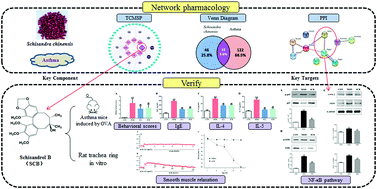Investigation of the active components and mechanisms of Schisandra chinensis in the treatment of asthma based on a network pharmacology approach and experimental validation†
Abstract
The aim of this paper was to investigate the active components of Schisandra chinensis in the treatment of asthma and the related mechanisms by a network pharmacology approach. The active components of Schisandra chinensis and the corresponding targets were obtained from the Traditional Chinese Medicine Systems Pharmacology Database and Analysis Platform (TCMSP). Eight active components in Schisandra chinensis and 56 related targets were screened out according to two indicators, oral bioavailability (OB) and drug-likeness (DL). A total of 132 targets related to asthma were screened out through Therapeutic Target Database (TTD) data. The String database and Cytoscape software were used to build the “drug-active compound-target” network and protein–protein interaction (PPI) network. The key targets were further predicted by the analysis of related biological processes and the pathway-enrichment. A total of 10 intersection targets between Schisandra chinensis and asthma were obtained by building Venn diagrams, and lignans in Schisandra chinensis were found to be associated with asthma. The key targets Ptgs2 and Nos2 were further screened out, and schisandrol B (SCB) was predicted as the most related key component to asthma. A mouse asthma model was established with ovalbumin and aluminum hydroxide for verifying the effect of SCB and related mechanisms. The results showed that SCB could inhibit the gene expression of proinflammatory factors to play a therapeutic role in asthma by reducing the expression of Nos2 and Ptgs2 and regulating the NF-κB signaling pathway to intervene in the process of cell metabolism in mice. These results suggest that SCB can alleviate the severity of asthma through the mechanisms predicted by network pharmacology, and provide a basis for further understanding of the application of Schisandra chinensis in the treatment of asthma.



 Please wait while we load your content...
Please wait while we load your content...